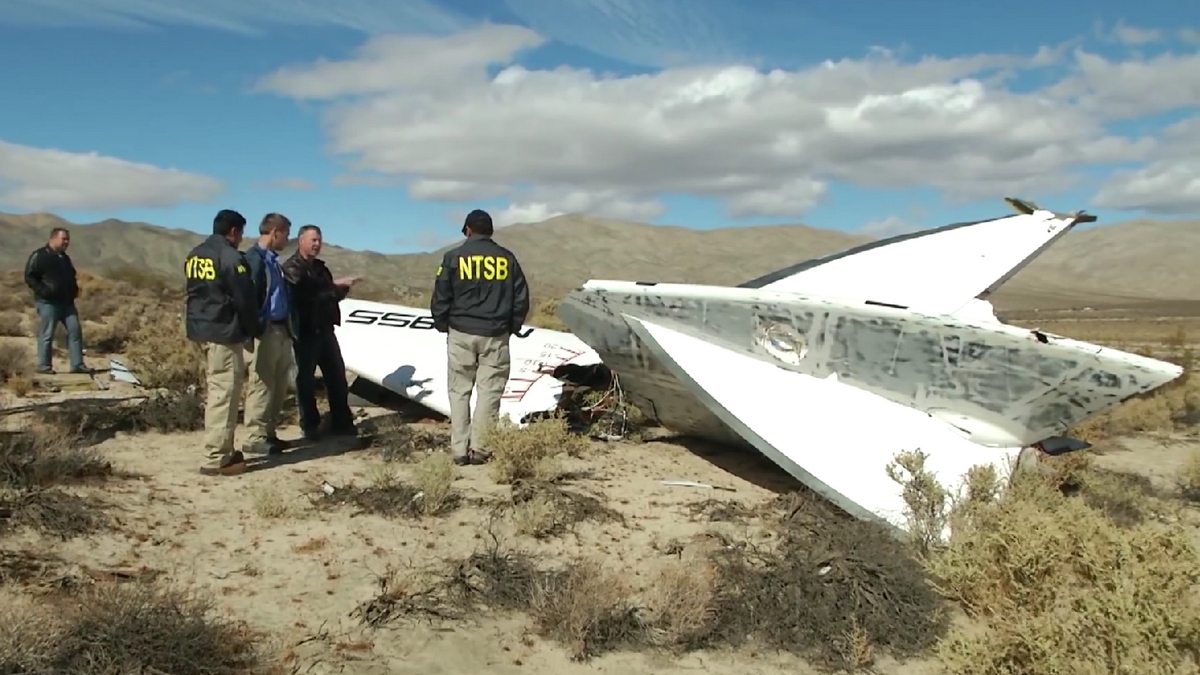Space tourism companies might learn a lesson from the Titan sub disaster. But are they ready to listen?
"It is exactly the kind of scenario that would trigger a big discussion if it were to happen in a space tourism flight."

For many experts involved in discussions over the need for (or lack of ) safety standards for the fledgling space tourism industry, the tragedy of the Titan submersible felt like their own nightmare scenario come true. But will the disaster that killed five people, including a 19-year-old university student, move the needle toward a more safety-first approach, or will arguments that innovation could suffer prevail?
When it comes to the absence of safety standards and technology oversight in space tourism, Tommaso Sgobba doesn't mince words. A former head of space safety at the European Space Agency, the Italian engineer has chaired over 800 safety reviews of payloads launched to the International Space Station during his ESA career and authored engineering text books on best safety practices in space systems design.
Now an executive director of the International Association of the Advancement of Space Safety (IAASS), Sgobba has been waging a quiet war for years against the exemption from safety oversight guaranteed to companies developing space tourism technologies by the U.S. Congress nearly two decades ago. When reports of the catastrophic implosion of an uncertified tourist submersible during a sight-seeing trip to the Titanic wreck emerged, Sgobba couldn't fail to notice similarities.
"It is exactly the kind of scenario that would trigger a big discussion if it were to happen in a space tourism flight," Sgobba told Space.com in an interview. "In fact, we have a sort of an analogue here. You have a technology that goes into an extreme environment for the purpose of pleasure that doesn't give much chance to people to survive if something goes badly wrong."
Related: Do space tourists really understand the risk they're taking?
Sub disaster lessons for suborbital tourism
The similarities don't end here. Just like space tourism vehicles such as Virgin Galactic's SpaceShipTwo space plane or Blue Origin's New Shepard rocket, the Titan submersible didn't require independent certification to ferry paying customers into the ocean's depths. Then there were the somewhat dismissive claims regarding safety certifications made by Stockton Rush, the billionaire CEO of OceanGate, the company that built and operated Titan, unearthed by journalists in the wake of the disaster. In the face of criticism, Rush accused experts of stifling innovation and bragged about the standard-defying uniqueness of OceanGate's technology, while asserting the need to accept risk for the experience of a lifetime.
All these claims echoed arguments that Sgobba has heard over the years from the space tourism community. But for the veteran space safety engineer, those arguments always ring hollow.
Breaking space news, the latest updates on rocket launches, skywatching events and more!
"Standards in aviation and space have evolved from prescriptive requirements, which were telling you exactly how to build a system to something that expects you to demonstrate that you have performed your hazard analysis and addressed the main safety problems," Sgobba said. "In fact, if you want to fly a coffee machine to the International Space Station, you will have to comply with the same set of standards as if you were building a whole new module. So it is a lie to say that standards mean that someone will tell you exactly how to build your system."
A moratorium on regulations issued by the U.S. Congress in 2004 and extended several times prevents the U.S. Federal Aviation Administration (FAA) from intervening into issues related to the safety of participants on space tourism flights. The companies have to prove their flights don't pose any risk to those on Earth and other users of airspace and demonstrate that their space vehicles worked during one previous flight, an FAA spokesperson told Space.com in an earlier interview. This moratorium, however, is set to expire in October this year, and the Titan disaster might be just the argument that sways legislators toward ending the boundary-less regime.

Tommaso Sgobba is the executive director and board secretary of the International Association for the Advancement of Space Safety and former head of spaceflight safety at the European Space Agency (ESA). Now formally retired, Sgobba joined ESA in 1989 and worked as a product assurance and safety manager for all European crewed missions on the space shuttle, MIR station, and for the European research facilities for the International Space Station. In 2004, he received a NASA recognition award for outstanding contribution to the International Space Station and in 2007 the prestigious NASA Space Flight Awareness (SFA) Award.
The Commercial Spaceflight Federation, which represents space tourism companies in the U.S., has not responded to Space.com's request to comment on the possible implications of the OceanGate saga on their own interests. In a previous interview, however, the federation's president Karina Drees, argued against such regulations, citing the stifling of innovation as a key concern — the same argument made by Stockton Rush.
"The vehicles that have been designed today are quite different from each other," Drees told Space.com at the time. "And so if regulations had been written on any one style, then that would have really prevented some of these designs from coming to the market."
It is this type of reasoning that Sgobba objects to.
"The certification is essentially a peer-review of your design by an expert," Sgobba said. "Instead of waiting for an accident, you perform your hazard analysis in advance. The solution to your hazard analysis is entirely in your design and you get input from other people who understand this matter and that can help you to make your product as safe as possible."
SpaceX's private launches to orbit
Sgobba cites SpaceX as an example of a successful private space tourism operation, which had benefited from such regulatory inputs. The rocket company founded by billionaire Elon Musk developed its Crew Dragon spacecraft as part of NASA's Commercial Crew Program, which required the firm to pass NASA's stringent safety reviews. Since its first NASA-funded flight to the International Space Station in 2020, SpaceX has flown its own space tourism mission Inspiration 4 and established itself as a go-to provider for Axiom Space, a private U.S.-based company that has flown two private missions to the space station using SpaceX's Dragon capsules and Falcon 9 rockets. SpaceX has also signed contracts for more private Dragon spaceflights with U.S. billionaire Jared Isaacson under his Polaris program.
"There were requirements regarding safety that they had to fulfill in order to get paid for the future service," said Sgobba. "So we have over there a very clear scheme of how things should be working. The only difference is that in the future, it could not be NASA who does the certification."
For years, Sgobba has been advocating for an establishment of an independent Space Safety Institute, a non-government organization of industry experts modeled on the classification societies that oversee standards in the shipping industry and which would have been responsible for certifying the Titan submersible had it not avoided the process through a loophole.
Just like OceanGate, space tourism companies rely on informed consent, by which the participants accept risks, including the fact that they are taking a potentially life-threatening ride on an uncertified vehicle that no independent expert had seen.
In Space.com's earlier interview with the Commercial Spaceflight Federation, Drees compared the informed consent in space tourism to that signed by a patient undergoing an elective surgery, a comment that might raise eyebrows considering the heavily regulated nature of the medical sector.
The space safety community will likely closely follow how the Titan tragedy plays out in court and whether those informed consents will hold up against the years of Rush's documented disregard of other experts' opinions. Sgobba, for one, doubts they will.
"The best way to defend yourself in the case of an accident is to show that you have done things according to the rules," said Sgobba. "The fact that there was an implosion means that something was not safe and because they cannot show that they have applied the rules, there is no defense."
Christopher Johnson, a space law advisor at the Secure World Foundation, also thinks that the informed consents the Titan passengers signed are likely going to come under scrutiny.
"The idea is that the commercial actor who chooses to get into this pioneering spacecraft or submarine or whatever, chooses the level of risk they are comfortable with," Johnson told Space.com. "But to do this, the government places an obligation that an actor can only consent to the risk if they are informed of that risk. So what we can learn from this tragedy is how well and to what extent the company knew the risk and could somehow quantify or qualify that risk and convey it to their customer so that they could understand how safe that vehicle was."
The five people killed during the Titan implosion include OceanGate CEO Rush, British businessman Hamish Harding (who flew to space in 2022 on Blue Origin's New Shepard), French deep sea explorer Paul Henry Nargeolet, British/Pakistani businessman Shahzada Dawood and his 19-year old son Suleman.
The existing commercial spaceflight operations have not claimed any fatalities so far. Jeff Bezos' Blue Origin has conducted six successful crewed flights with its New Shepard vehicle. An uncrewed mission using the same rocket, however, failed in September 2022 after a booster malfunction. The company has said it expects to resume flights in upcoming weeks, according to SpaceNews.
Blue Origin's rival Virgin Galactic plans to conduct its second commercial mission later this week, on June 29. The company, which charges $450,000 for suborbital flights offering about five minutes of weightlessness, has suffered a fatal accident during a test flight in 2014 that killed one of the two pilots aboard and injured the other. The cause of the crash was traced down to the premature deployment of the plane's braking system brought about by human error.
Virgin Galactic's first crewed mission in 2022 veered off its approved flight envelope due to the company's failure to account for strong high-altitude winds. The incident resulted in an FAA investigation and the grounding of further flights until its resolution.
On May 25, Virgin Galactic launched a crew of six, two pilots and four passengers, on its final suborbital test flight before beginning commercial operations. That mission marked the company's fifth spaceflight with its SpaceShipTwo Unity space plane.
On Monday (June 26), the company announced its June 29 target to launch its first commercial flight, called Galactic 01, which will carry three members of the Italian Air Force alongside a Virgin Galactic astronaut trainer and two pilots.
"Galactic 01 is our first commercial spaceflight, and we're honored to have been selected by the Italian Air Force and the National Research Council to support their first space research mission, 'Virtute 1,'" Virgin Galactic CEO Michael Colglazier said in a statement. "Virgin Galactic’s research missions will usher in a new era of repeatable and reliable access to space for government and research institutions for years to come."

Tereza is a London-based science and technology journalist, aspiring fiction writer and amateur gymnast. She worked as a reporter at the Engineering and Technology magazine, freelanced for a range of publications including Live Science, Space.com, Professional Engineering, Via Satellite and Space News and served as a maternity cover science editor at the European Space Agency.
